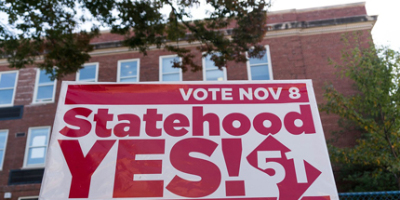DC Government Champions Statehood
On election day, November 8, 2016, eighty-seven percent of DC voters said “Yes” to statehood
Council Chair Vincent Gray had an interest in statehood, even when DC’s elected leaders were very focused on the House Voting Rights Act. In 2009, he appointed a Special Council Committee on Statehood and Self-Determination and led a delegation of Councilmembers to the National Conference of State Legislatures to promote DC statehood.
After his election as mayor, Gray spoke eloquently about statehood during his inaugural address in early 2011. He also spoke forcefully during DC’s statehood rally at the World War I memorial in August of 2013. After the rally, he led the DC march to the Lincoln Memorial to join the main anniversary commemoration of the 1963 March on Washington.
By 2013, the conventional wisdom among Washingtonians, DC’s Mayor and Council included, was that when self-determination came to the people of DC, it would come through statehood. However, neither Mayor Gray nor members of the Council expressed any urgency about statehood, and the DC government’s financial investment in achieving self-determination continued to be very modest.1
Statehood advocates did not see the 2014 Mayoral campaign as particularly relevant to their cause, even though it was included in the platforms of both Mayor Gray and Muriel Bowser, the challenger who defeated him. It was not a major issue in the campaign, and it had been twenty years since a DC mayor had given serious attention to statehood.2
Mayor Muriel Bowser’s dramatic announcement of her statehood initiative at the DC government’s annual Emancipation Day breakfast in April of 2016 surprised most Washingtonians. Statehood advocates were thrilled that statehood was at last becoming a priority of the DC government. They were, however, disappointed that the Mayor had not consulted them about her initiative,
Bowser modeled her initiative on the Tennessee Plan. The would-be 51st state was taking the approach pioneered by the territory of Tennessee and later used by six other territories to enter the union. Her plan for January 2017 was to present Congress with a formal petition for statehood and a new constitution ratified by DC voters in a statehood referendum during the November election.3
Since the new constitution had to be ready for ratification by November, there wasn’t time for a convention of democratically elected delegates to craft the new constitution. In early May, the New Columbia Statehood Commission released a draft constitution. The new state government created by the Mayor’s 21-member legal team resembles the current DC government with delegates instead of councilmembers, a governor instead of a mayor, and state agencies instead of District agencies. The members of the New Columbia Statehood Commission were Mayor Muriel Bowser, Council Chair, Phil Mendelson, Shadow Senators, Michael D. Brown and Paul Strauss, and Shadow Representative, Franklin Garcia.
In May and June, the New Columbia Statehood Commission held a series of town halls where people could comment on the draft constitution. And in mid-June, three 4-hour sessions, called a constitutional convention, provided further opportunities for DC citizens to weigh in. People could also submit comments and amendments online. During the town halls and “convention” sessions, statehood advocates and other Washingtonians who felt strongly about a democratically developed constitution urged that the constitution include a requirement for a constitutional convention with elected delegates to be held two years after the admission of the 51st state. But this requirement was not included in the revised constitution, released by the New Columbia Statehood Commission at the end of June.4
The final step in the development of the new constitution was review and possible revision by the DC Council. In October, the DC Council made two significant changes to the constitution of the proposed 51st state. In response to the advocacy of statehood advocates and others concerned about a democratically developed constitution, it added the requirement for a constitutional convention with elected delegates to be held two years after statehood. The Council’s revision also requires that any constitutional amendments adopted by the convention be approved by the voters of the new state. The other change made by the Council was the new name for the 51st state. The Council renamed it the State of Washington, D.C., with D.C. standing for Douglass Commonwealth, in honor of the abolitionist and DC resident Frederick Douglass.5
Statehood advocates looked forward to the November election with optimism. They were pleased that DC statehood was again in the Democratic National Committee’s platform, after a 12-year absence. The statehood referendum increased the ranks of advocates, and DC Vote joined the campaign. On election day in 2016, eighty-seven percent of DC voters approved the statehood referendum. The very large number of voters who supported statehood can, in part, be attributed to the summer canvassing by DC vote in 2015 and 2016. With ninety-six percent of their votes, DC voters also overwhelmingly supported Hillary Clinton. Voters in the 50 states, however, elected a President and a Congress that were not ready to admit the 51st state.6
1 “Some Things Haven’t Changed since 1963 March,” Washington Post, Aug 30, 2013.
2 “D.C. Mayoral Candidates Have Very Different Plans to Advance Statehood Effort, “Washington Post, Sep 17, 2014.
3 “In Quest to be the 51st State. D.C. Convenes First Constitutional Convention of the 21st Century,” Washington Post, June 16, 2016.
5 “D.C. Council Cedes More Power of Statehood Constitution to Residents,” Washington Post, Oct 18, 2016.
6 “District Voters Overwhelmingly Approve Referendum to Make D.C. the 51st State,” Washington Post, Nov 9, 2016.
Where to Find Us:
New Columbia Vision
1651 HOBART ST NW
Washington, DC 20009
Phone: 202 387-2966
What's New
Extended business hours
To accomodate our customers' busy schedules, we have extended our hours and are now open later.
Special Facebook Promotion!
Like us on Facebook and get 10% off your next order.


